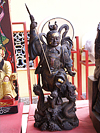|
Nezha (哪吒)
Chinese. Name of a
Taoist
child-deity. He was the third son of Li Jing, a high-ranking
military commander at the Old Pond Pass, and Lady Yin. His elder
brothers were named Jinzha and Muzha. His mother gave birth to a
ball of flesh after being pregnant with him for 42 months. Li Jing
thought that his wife had begotten a demon and he attacked the ball
with his sword. The ball split open and Nezha jumped out as a young
boy, already able to walk and speak at birth. Nezha would soon cause
untold chaos and trouble, as one day, while playing near the sea, Nezha fought and killed Ao Bing (fig.), the third son of Ao Guang, the
Dragon King of the East Sea, who in response threatened to report Nezha to the
Jade Emperor and flood the Old Pond
Pass, whilst capturing his parents. To save them Nezha sacrificed
himself, offering Ao Guang all of his internal organs in
exchange for his parents. The Dragon King (fig.)
was moved by this gesture and –though killing the boy– he spared his
family. Later, Nezha was brought back to life
by an immortal, who used
lotus roots (fig.) to construct a human
body for his soul, and Nezha became a protection deity. In art, Nezha is depicted as a youth, usually
holding a Golden Hoop, Ring of Fire or Universe Ring in his left hand and a Fire Spear in his right
hand, whilst subduing a Sea Dragon, and standing on a
Wheel of Fire
(fig.), with which he can travel
through the sky and that is able to carry him swiftly to whichever place he wishes
to go. The Golden Hoop is a magical
ring, which can change its size freely as Nezha wishes, whereas the Fire Spear
is a fire-tipped lance that he uses as a weapon. His official Taoist
title
is
Zhong Tan Yuan Shua, i.e.
‘First Commander of the Central
Alter’, which is usually translated as ‘Marshal
of the Central Altar’ (fig.), and
–after he became a warrior deity– he was
given the title
Lian Hua San Taizi, i.e. ‘Third Lotus Prince’
(fig.).
He is sometimes depicted with three faces, of which one is red and another green,
and with six arms (fig.),
a form known as
san tou liu bi
and used to describe his great power and remarkable abilities, such
as his ability to spit
rainbows, as
described in certain legends.
Originally, Nezha is a Vedic god
known by the Sanskrit name Nalakuvara, son of the Hindu god
Kuvera and
twin brother of Manigrivia. The royal Thai-Chinese temple
Wihaan Thep Sathit Phra Kiti
Chaleum
(fig.)
in
Chonburi
is dedicated to this deity. Also pronounced Na Zha and
sometimes referred to as Nazha (or Nezha) San Taizi (哪吒三太子), i.e. ‘Nezha,
the Third Prince’.
回






|

